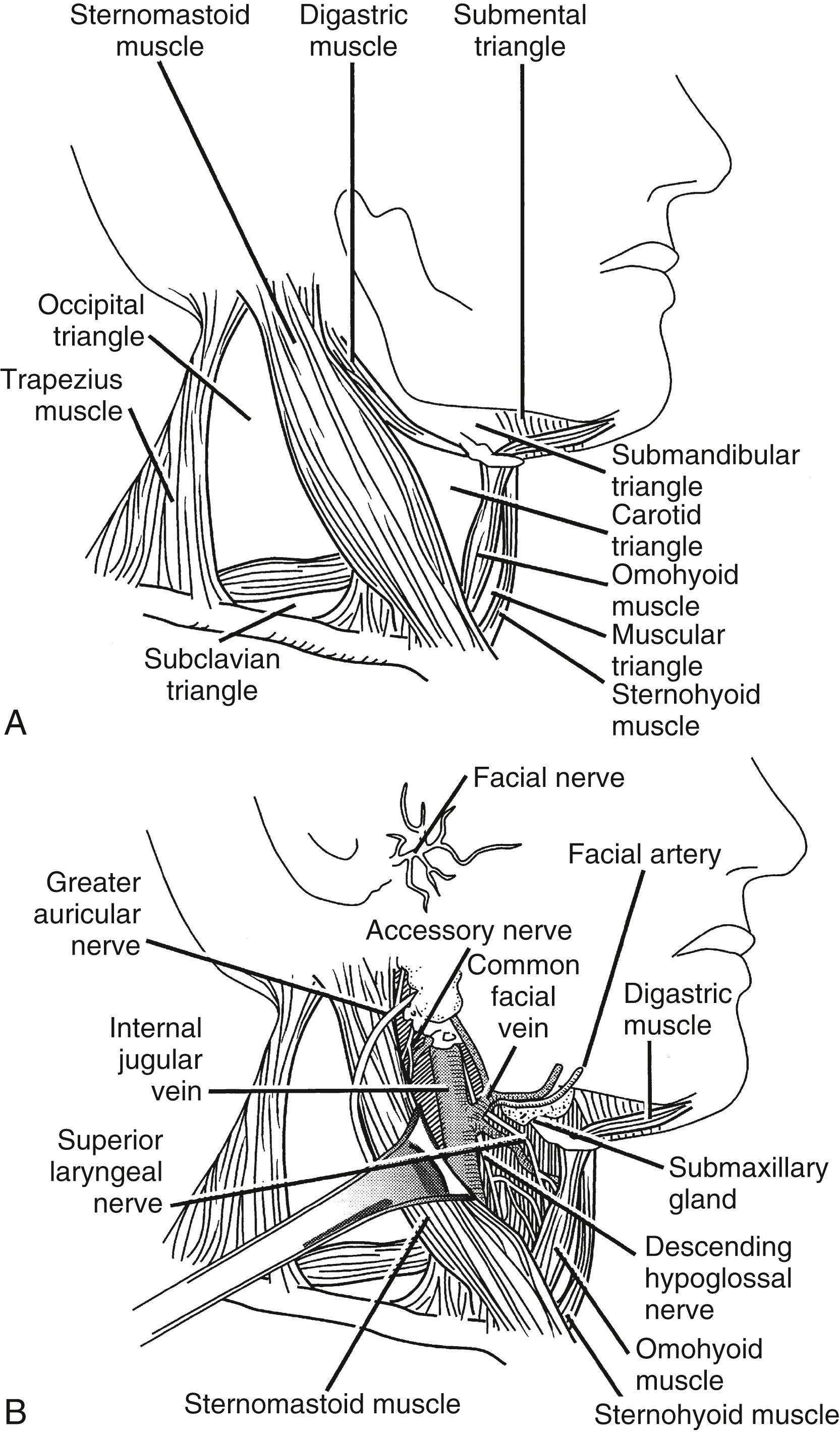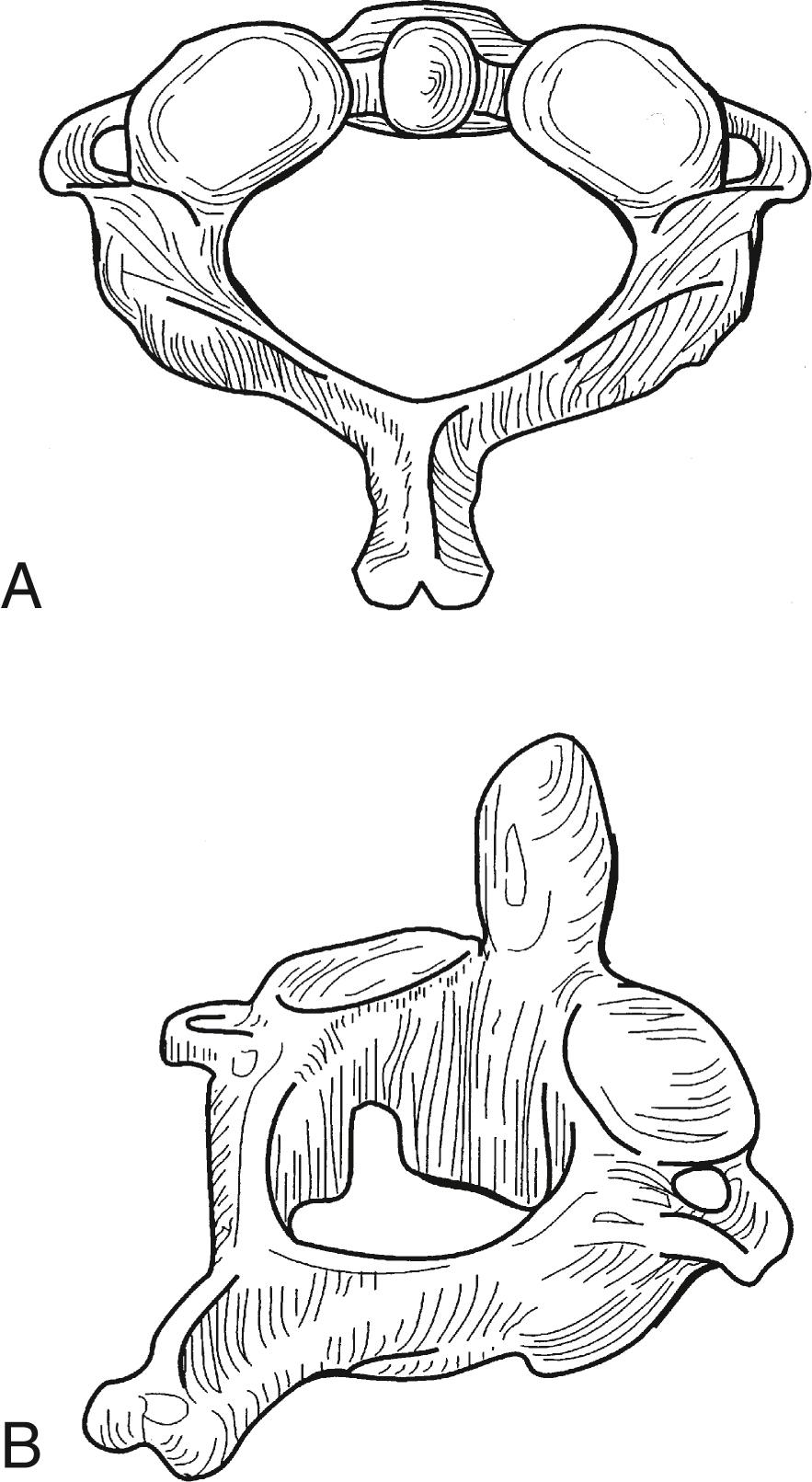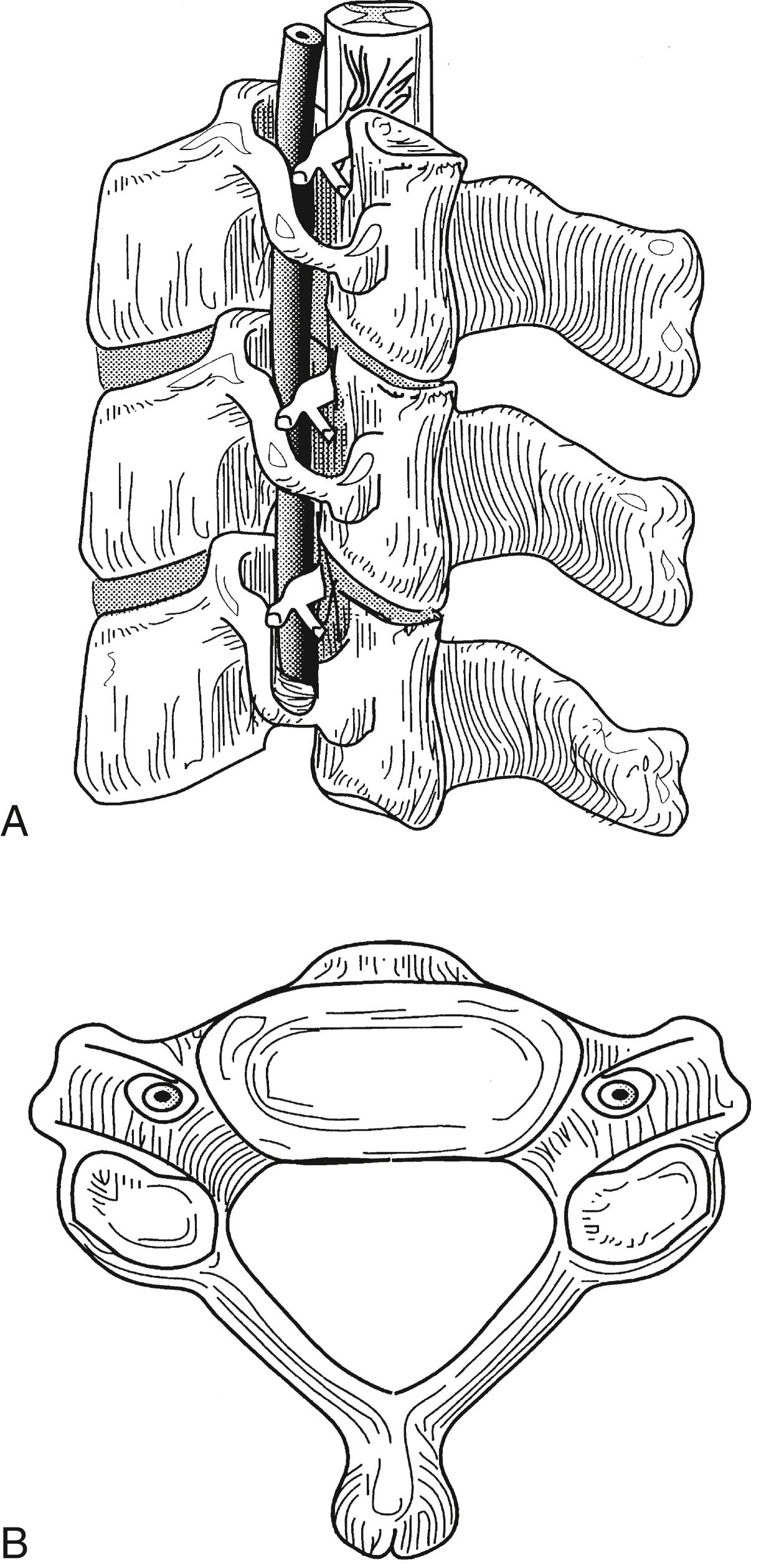Physical Address
304 North Cardinal St.
Dorchester Center, MA 02124
Understanding the anatomy of the cervical spine and neck is of the utmost importance for the surgeons operating in this region.
The anatomy of this region can be classified from superficial to deep and further analyzed by system, including muscle, bone, nerves, vasculature, and soft tissue.
Each level of the cervical spine has unique bony anatomy, and as a result the location of the surrounding anatomic structures varies from one region to another. The nuances of this anatomy influence the surgical approach at each level.
It is important to understand common pathologies affecting the subaxial cervical spine and the cervicothoracic junction.
This chapter will explore posterior surgical techniques commonly employed to address pathology of the subaxial cervical spine and cervicothoracic junction.
The authors would like to thank Dr. Tyler J. Kenning and Dr. Alexander R. Riccio for their contributions to the previous edition of this chapter.
Knowledge of the surface anatomy of the neck is essential when planning cervical spine surgery. The most prominent structure of the upper dorsal surface of the nuchal region is the inion, or occipital protuberance. This may be palpated in the midline and is a part of the occipital bone. The spinous processes of the cervical vertebrae may then be followed caudally to the vertebral prominence, variably corresponding to the spinous process of C6, C7 (most common), or T1.
The sternocleidomastoid muscle divides the neck into two large triangles, posterior and anterior, which are then subdivided into two and four triangles, respectively ( Fig. 104.1 ). The posterior (dorsal) triangle is important when using posterior cervical approaches. The borders of the posterior (dorsal) triangle are the dorsal edge of the sternocleidomastoid muscle, the ventral edge of the trapezius muscle, and the middle third of the clavicle. The deep cervical fascia covers the dorsal cervical triangle, thus forming its roof. The floor of the dorsal cervical triangle is formed by the scalenus posterior, scalenus medius, levator scapulae, and splenius capitis muscles, as well as the lateral extension of the prevertebral fascia that overlies these muscles. The dorsal belly of the omohyoid muscle partitions the dorsal cervical triangle into a large rostral occipital triangle named for the occipital artery exiting at its apex and a small caudal subclavian triangle named for the subclavian artery, which lies deep to it.

The spinal accessory nerve leaves the deep surface of the sternocleidomastoid muscle to enter the dorsal triangle of the neck, which it crosses to innervate the trapezius muscle. The two important structures found in the dorsal cervical triangle, which arise above the spinal accessory nerve, are the occipital artery and the lesser occipital nerve. The occipital artery leaves the dorsal cervical triangle at its apex, where the sternocleidomastoid and trapezius muscles approach one another on the superior nuchal line. This artery then ascends to supply the dorsal scalp. The lesser occipital nerve ascends along the dorsal surface of the sternocleidomastoid muscle before dividing into several superficial branches that supply the scalp dorsal to the ear.
Caudal to the spinal accessory nerve are many important anatomic structures. The external jugular vein, which is formed by the confluence of the posterior auricular and the posterior division of the retromandibular vein at the angle of the mandible, courses over the sternocleidomastoid muscle obliquely to enter the dorsal cervical triangle caudally, en route to joining the subclavian vein approximately 2 cm above the clavicle. Two branches of the thyrocervical trunk cross the dorsal cervical triangle. The suprascapular artery runs rostral to the clavicle before passing deep to the clavicle to supply the periscapular muscles. The transverse cervical artery lies 2 to 3 cm rostral to the clavicle and runs laterally across the dorsal cervical triangle to supply the periscapular muscles.
Three superficial nerves also exit the dorsal triangle below the spinal accessory nerve. In all cases, these nerves arise from the cervical plexus, which is formed by the ventral rami of the rostral four cervical spinal nerves. The plexus lies within the lateral neurovascular conduction pathways located between the internal jugular vein and the sternocleidomastoid muscle. The superficial nerves then arise along the middle portion of the dorsal border of the sternocleidomastoid muscle to supply the skin of the neck and scalp between the mastoid process and the inion. The great auricular nerve crosses the sternocleidomastoid muscle and ascends toward the parotid gland, branching into dorsal and ventral rami that supply the skin in an area stretching from the angle of the mandible to the mastoid process and the skin of the neck. The transverse cervical nerve also crosses the sternocleidomastoid muscle to supply the skin overlying the ventral cervical triangle. The supraclavicular nerves arise from a single trunk that trifurcates into lateral, intermediate, and medial branches that innervate the skin of the neck, ventral chest, ventral shoulder, sternoclavicular joint, and acromioclavicular joint. The phrenic nerve arises in part from the cervical plexus and in part from the brachial plexus. The brachial nerve arises near the scalenus anterior muscle, where it crosses ventromedially and deep to the transverse cervical and suprascapular arteries and the prevertebral fascia, to descend through the superior thoracic aperture near the origin of the internal mammary artery. The upper, middle, and lower trunks of the brachial plexus lie deep to the floor of the posterior cervical triangle. They emerge between the scalenus medius and scalenus anterior muscles and cross deep to the transverse cervical and suprascapular arteries to descend under the clavicle to enter the axilla.
The upper cervical spine is characterized by the axis and its “anatomic neighbors” ( Fig. 104.2 ). The subaxial cervical spine varies minimally from level to level and is discussed as a single unit ( Fig. 104.3 ). The components of the subaxial vertebrae include the body, upper and lower articular processes, pedicles, lamina, and spinous process. The vertebral bodies are the axial loadbearing elements of the spine. In the subaxial cervical spine the vertebral body height increases as the spine is descended, with a slight reversal of this relationship at C6, which is usually shorter than either C5 or C7. Each body has a dorsally directed concavity that forms the ventral spinal canal. From each body arise three body projections: rostrally the uncus, laterally the ventral ramus of the transverse process, and dorsolaterally the pedicle.


The rostral aspect of each of the lower cervical vertebral bodies contains the uncus, a dorsolateral bony projection. The uncus gives the body a rostrally concave shape in the coronal plane and enables the vertebral body to receive the rounded caudal aspect of the immediately adjacent vertebral body, sometimes overlapping the next level by one-third of the vertebral body height. The uncovertebral joints limit lateral translation and contribute to the coupling of lateral bending and rotation of the cervical spine.
The anterior tubercle arises from the rostral vertebral body and projects laterally, whereas the posterior tubercle arises from the midportion of the lateral mass and projects ventromedially to join the anterior tubercle. The lateral surface of the pedicle, the dorsal surface of the anterior tubercle, and the ventral surface of the posterior tubercle form the foramen transversarium, which transmits the vertebral artery from C6 to the atlas. The anterior scalene, longus colli capitis, longus colli cervicalis, and ventral intertransversus muscles take their origin from the anterior tubercles. The splenius cervicalis, longissimus, levator scapulae, middle scalene, posterior scalene, and iliocostalis take their origin from the posterior tubercle. On the rostral surface of each transverse process there is a prominent groove carrying the exiting nerve root.
The pedicles of the subaxial cervical spine connect the vertebral bodies, whose lateral masses are small and medially oriented. The lateral masses of the subaxial cervical spine consist of superior and inferior articulating surfaces that form the facet joint. The facet joint is a coronally oriented synovial joint that is protected by a thin capsule. The vascular supply to the joint capsule arises from the vertebral, ascending pharyngeal, deep transverse cervical, supreme intercostal, and occipital arteries. The facet joints are innervated by the dorsal branches of the spinal nerves, which enter the joint at the center of the dorsal capsule.
The cervicothoracic junction (CTJ) acts as transition between the mobile cervical spine, which is paramount in providing flexion and extension, and the rigid thoracic vertebrae and cage. The cervicothoracic junction is defined as the C7 vertebra, the intervertebral disc, the associated ligaments, and the T1 vertebra. In practice, however, it is often referred to as covering the C7‒T3 region, as the challenges of surgery, associated pathologies, and need for instrumentation often extend past T1. Because of this unique transition zone, the CTJ can be predisposed to unique forces not seen in other areas of the spinal column. The surface and bony anatomy in this area can be easily palpated, as the C7 and T1 spinous process are much more prominent than the rest of the subaxial spine, which tend to be bifid. The bony anatomy of the CTJ from C7‒T3 undergoes significant changes as we descend through the spine. The overall width of the vertebral bodies increases from C6 to T1 and then progressively declines throughout the thoracic spine, whereas the anteroposterior distance increases. C7 tends to have largest spinous process because of its nuchal ligament attachment. C7 houses a small transverse foramina, which vertebral arteries pass through in only 3% of individuals; more commonly, these arteries transverse at the C6 level. Pedicular width increases from C6 to T1 and then once again decreases from T1 to T5. The pedicle medial angle decreases from C7 to T2, and the lateral mass is thinnest at C7 and thickest at T1 in the CTJ. The spinal cord and vertebrae share a unique relationship at the CTJ. The spinal canal at the CTJ is at its narrowest point, whereas the spinal cord at this location is at one of its largest diameters; thus, the spinal cord is at risk for compressive pathologies.
The intervertebral discs adjoin each of the subaxial vertebral bodies and contribute significantly to the flexibility of the spine. The cartilaginous end plates of the bordering vertebral bodies are the rostral and caudal boundaries of the disc space, and the anterior and posterior longitudinal ligaments (PLLs) overlie, respectively, the ventral and dorsal surfaces of the intervertebral disc space. Laterally, the disc space is limited by the uncal process. The end plate is more substantial on its periphery than centrally and is composed of hyaline cartilage. The disc itself is composed of the gelatinous nucleus pulposus surrounded by a fibrous ring. The fibrous ring contains intersecting layers of predominantly collagen and, to a lesser extent, elastin fibers.
Become a Clinical Tree membership for Full access and enjoy Unlimited articles
If you are a member. Log in here